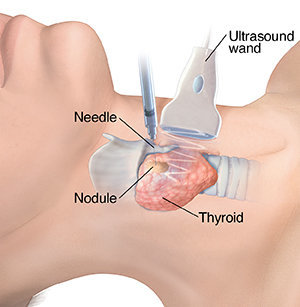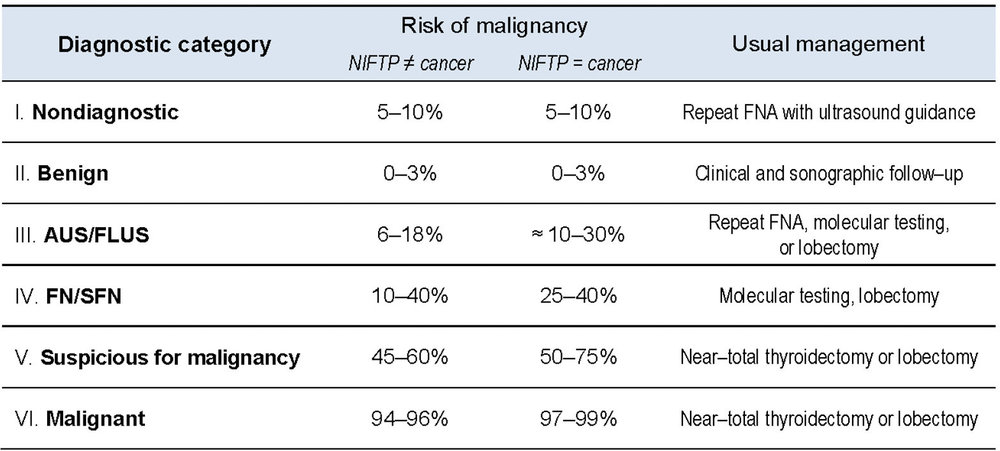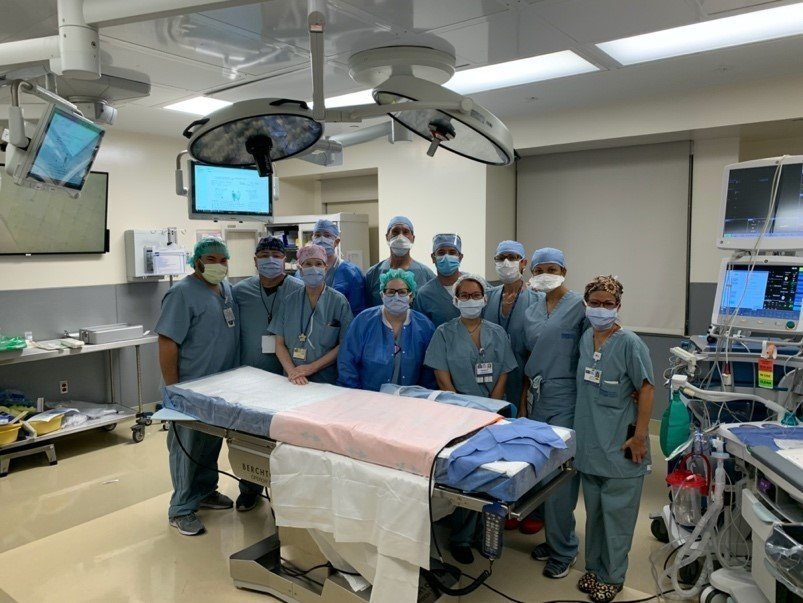Thyroid Biopsy Results Explained: What Your Report Really Means
Thyroid Biopsy Results Explained: What Your Report Really Means
If you’ve recently had a fine-needle aspiration (FNA) of your thyroid nodule, you’re probably wondering: What do my thyroid biopsy results actually mean? The terminology in pathology reports can be confusing and even alarming. That’s why we’ve created this guide to help you better understand your thyroid biopsy results and what they mean for your next steps.
At the Clayman Thyroid Center, we specialize in evaluating and treating patients with thyroid nodules, and we’re here to demystify the process.
Thyroid Biopsy Results Explained: What Is a Fine-Needle Aspiration (FNA)?
Before diving into how to interpret thyroid biopsy results, it’s important to understand what an FNA biopsy is. A fine-needle aspiration uses a very thin needle to collect cells from your thyroid nodule. These cells are then examined under a microscope by a pathologist, who classifies them using a system known as the Bethesda System for Reporting Thyroid Cytopathology.
Your thyroid biopsy results will fall into one of six Bethesda categories, each with its own level of cancer risk and recommended management strategy.

Figure 1: Depicts a fine needle aspiration (FNA) biopsy of a thyroid nodule, guided by ultrasound to collect cells for diagnosis. This procedure is commonly used to determine whether a thyroid nodule is benign or cancerous.
Thyroid Biopsy Results Explained: The Six Bethesda Categories
The Bethesda System provides a standardized way for pathologists and doctors to interpret and act on thyroid biopsy results. Here's what each category means:
Bethesda I: Non-Diagnostic or Unsatisfactory
- What it means: Not enough cells were collected to make a diagnosis.
- Next step: A repeat biopsy is usually recommended.
- Thyroid biopsy results tip: This doesn’t mean anything is wrong—it just means more tissue is needed.
Bethesda II: Benign
- What it means: The nodule is non-cancerous.
- Cancer risk: Less than 3%
- Next step: Routine follow-up with ultrasound; no surgery needed in most cases.
- Thyroid biopsy results tip: This is the most common and most reassuring result.
Bethesda III: Atypia of Undetermined Significance (AUS) or Follicular Lesion of Undetermined Significance (FLUS)
- What it means: Cells look slightly unusual but aren’t clearly cancerous.
- Cancer risk: ~5–15%
- Next step: Repeat biopsy or molecular testing may be suggested.
- Thyroid biopsy results tip: This is often considered a gray zone and needs further evaluation by a specialist.
Bethesda IV: Follicular Neoplasm or Suspicious for a Follicular Neoplasm
- What it means: A pattern suggesting possible follicular thyroid cancer.
- Cancer risk: ~15–30%
- Next step: Often surgical removal of the lobe to confirm diagnosis.
- Thyroid biopsy results tip: A follicular neoplasm cannot be definitively diagnosed without examining the nodule’s capsule under a microscope—this requires surgery.
Bethesda V: Suspicious for Malignancy
- What it means: Cells show some features of thyroid cancer, but are not conclusive.
- Cancer risk: ~60–75%
- Next step: Surgery is typically recommended.
- Thyroid biopsy results tip: Don’t panic—many patients with this category still have curable, early-stage thyroid cancer.
Bethesda VI: Malignant
- What it means: The nodule is cancerous, most commonly papillary thyroid cancer.
- Cancer risk: >97%
- Next step: Surgery is required to remove the cancerous thyroid tissue.
- Thyroid biopsy results tip: With expert surgical care, papillary thyroid cancer has a cure rate over 95%.

Figure 2: Outlines the Bethesda System, which guides the next steps after a thyroid biopsy based on six diagnostic categories ranging from nondiagnostic to malignant.
Thyroid Biopsy Results Explained: What If My Results Are Indeterminate?
Nearly 20–30% of thyroid biopsy results fall into the “indeterminate” categories—Bethesda III and IV. This can be frustrating and confusing for patients who want clear answers.
If your thyroid biopsy results fall into these categories, additional tools like molecular testing (to analyze genetic markers) or surgical consultation may help clarify whether the nodule is cancerous. At the Clayman Thyroid Center, we evaluate each case individually to recommend the most accurate and least invasive course of action.
Thyroid Biopsy Results Explained: Why Expert Review Matters
Thyroid biopsy results aren’t always black and white. A second review by a thyroid-specific pathologist can sometimes yield a different diagnosis, especially in Bethesda III or IV cases. Similarly, imaging quality, biopsy technique, and the expertise of your care team all influence the reliability of your thyroid biopsy results.
Choosing a center that specializes in thyroid nodules and thyroid cancer dramatically improves your chances of an accurate diagnosis and an appropriate treatment plan.
Thyroid Biopsy Results Explained: Do All Suspicious Nodules Require Surgery?
Not necessarily. While Bethesda V and VI categories often require surgery, decisions about Bethesda III and IV nodules depend on:
- Size of the nodule
- Growth over time
- Molecular test results
- Family history
- Patient age and risk factors
At our center, we combine biopsy results with high-resolution ultrasound and patient-specific factors to recommend whether observation, repeat biopsy, or surgery is best.
Thyroid Biopsy Results Explained: What Questions Should I Ask?
If you’ve received your thyroid biopsy results and don’t know what to do next, here are a few questions to ask your provider:
- What Bethesda category is my result?
- What is the estimated risk of cancer?
- Should I consider a second opinion?
- Is molecular testing appropriate in my case?
- Do I need surgery or continued observation?
Understanding your thyroid biopsy results empowers you to make confident, informed decisions about your care.
Thyroid Biopsy Results Explained: Why Choose Clayman Thyroid Center?
If your thyroid biopsy results are unclear, suspicious, or cancerous, you deserve care from experts who focus only on thyroid disease and thyroid cancer. At the Clayman Thyroid Center, our team:
- Performs thousands of thyroid surgeries annually
- Has decades of focused experience in thyroid cancer treatment
- Uses advanced imaging, in-house biopsy review, and personalized surgical planning
- Maintains one of the lowest complication and recurrence rates in the country
.jpg)
Figure 3: Shows the Clayman Thyroid Center surgical team, ready to provide specialized care.
Conclusion: Thyroid Biopsy Results Explained, Simply and Clearly
Your thyroid biopsy results are more than just a line in a report—they’re the key to understanding what’s happening in your body and what you need to do next. Whether your result is benign, indeterminate, or malignant, expert evaluation and personalized care can make all the difference.
If you’ve received thyroid biopsy results and want a second opinion or surgical consultation, we’re here to help. Contact the Clayman Thyroid Center to schedule a review with one of our expert thyroid surgeons.
Additional Resources
- Become our patient by filling out the form at this link.
- Learn more about The Clayman Thyroid Center here.
- Learn more about our sister surgeons at the Scarless Thyroid Surgery Center, Norman Parathyroid Center, and Carling Adrenal Center
- Learn more about the Hospital for Endocrine Surgery.